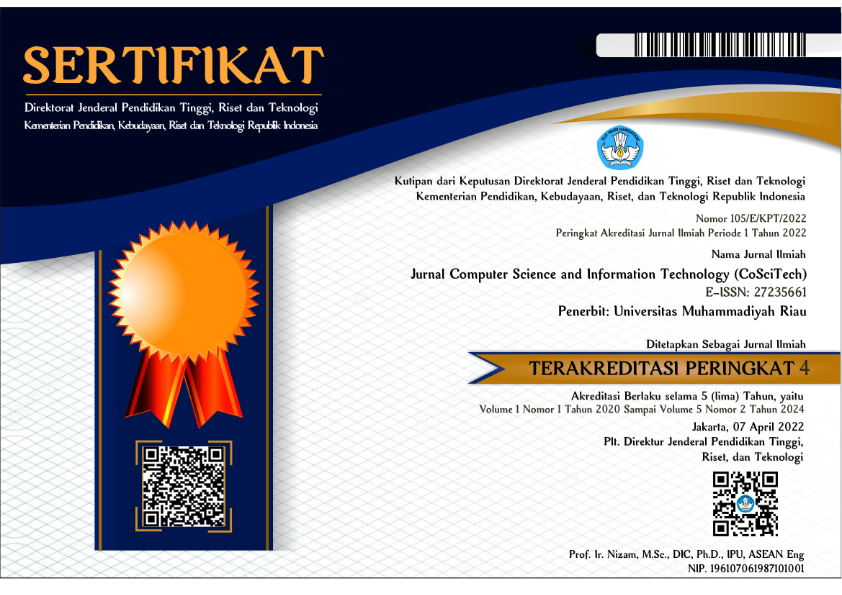Analisis kualitas udara menggunakan internet of things di pintu perlintasan kereta api
DOI:
 https://doi.org/10.37859/coscitech.v4i3.6219
https://doi.org/10.37859/coscitech.v4i3.6219
Abstract
The limited number of air quality sensors causes the presentation of Air Quality Index information to be not optimal. In principle, the installation of Air Quality Index sensors can provide input in air quality control and monitoring policies in an area. However, some places that have the potential to become local tourism or gathering places such as around the railroad crossing area do not have air quality sensors installed. Wind speed when trains pass can cause dust to scatter. Therefore, it is necessary to conduct further studies related to air quality around railroad crossings. Therefore, this research proposes to analyze and monitor air quality around railroad crossings in the Special Region of Yogyakarta based on the Internet of Things. In this study, the installed sensors functioned to monitor air quality at 3 locations that have different characteristics so that the data generated is also different. Based on the PM25 sensor, the air quality is categorized as Good 50% and Moderate 50%, while the PM10 sensor is categorized as Good 80% and Moderate 30%. The Internet of Things sensor built in this study is still not integrated in its recording between wind speed and air quality.
Downloads
References
[2] N. P. Decy Arwini, “Dampak Pencemaran Udara Terhadap Kualitas Udara di Provinsi Bali,” J. Ilm. Vastuwidya, vol. 2, no. 2, pp. 20–30, Jun. 2020, doi: 10.47532/jiv.v2i2.86.
[3] P. Agista, N. Gusdini, and M. Maharani, “Analisis Kualitas Udara dengan Indeks Standar Pencemar Udara (ISPU) dan Sebaran Kadar Polutannya di Provinsi DKI Jakarta,” Sustain. Environ. Optim. Ind. J., vol. 2, no. 2, pp. 39–57, Sep. 2020, doi: 10.36441/seoi.v2i2.491.
[4] Khoiron and A. D. Moelyaningrum, “Analisis Kualitas Udara Ambien di Kabupaten Jember Sebagai Salah Satu Indikator Kota Sehat,” Bul. Poltanesa, vol. 23, no. 1, pp. 134–139, Jun. 2022, doi: 10.51967/tanesa.v23i1.1084.
[5] T. V. Damayanti and R. E. Handriyono, “Monitoring Kualitas Udara Ambien Melalui Stasiun Pemantau Kualitas Udara Wonorejo, Kebonsari Dan Tandes Kota Surabaya,” ENVITATS Environ. Eng. J. ITATS, vol. 2, no. 1, pp. 11–18, Mar. 2022, doi: 10.31284/j.envitats.2022.v2i1.2897.
[6] A. C. Hugo, R. Hidayat, and L. Nurpulaela, “Implementasi Internet Of Things Sebagai Monitoring Suhu Pada Pemanggang Otomatis Berbasis Arduino UNO,” Electro Luceat, vol. 6, no. 2, pp. 334–345, Nov. 2020, doi: 10.32531/jelekn.v6i2.278.
[7] D. Mualfah, G. H. Sandi, and E. Fuad, “Sistem Monitoring pH dan Kelembaban Tanah pada Tanaman Kacang Tanah Berbasis IoT (Internet of Things),” 2023.
[8] F. Sadikin and S. Kumar, “ZigBee IoT Intrusion Detection System: A Hybrid Approach with Rule-based and Machine Learning Anomaly Detection,” in Proceedings of the 5th International Conference on Internet of Things, Big Data and Security, SCITEPRESS - Science and Technology Publications, 2020, pp. 57–68. doi: 10.5220/0009342200570068.
[9] Muhamad Fajar and Adhitia Erfina, “Rancang bangun sistem monitoring curah hujan berbasis internet of things,” J. CoSciTech Comput. Sci. Inf. Technol., vol. 4, no. 1, pp. 42–49, May 2023, doi: 10.37859/coscitech.v4i1.4502.
[10] Cisco Systems, “The Internet of Things References Model,” Cisco Systems, 2014.
[11] A. Hanafi and K. Kharisma, “Pengembangan Sistem Dashboard Administrator Pada Sipp-Mas Jogja Kota,” Respati, vol. 17, no. 2, Aug. 2022, doi: 10.35842/jtir.v17i2.448.
[12] G. Gurning, P. Pangaribuan, and K. Afifah, “Sistem Pengendalian Tirai Dan Jendela Otomatis Pada Sebuah Gedung,” in e-Proceeding of Engineering, in 5, vol. 9. Telkom University, 2022.
[13] I. B. M. L. Pradirta, I. N. Piarsa, and I. P. A. Dharmaadi, “Sistem Pendeteksi Banjir dan Badai Angin serta Monitoring Cuaca Berbasis Internet of Things,” J. Teknol. Inf. Dan Ilmu Komput., vol. 9, no. 5, p. 1037, Oct. 2022, doi: 10.25126/jtiik.2022955983.
[14] M. L. Mahar, A. R. Al Tahtawi, and S. Sudrajat, “Perancangan dan Realisasi Anemometer Digital untuk Aplikasi Sistem Peringatan Dini,” J. Teknol. Rekayasa, vol. 2, no. 2, p. 91, Feb. 2018, doi: 10.31544/jtera.v2.i2.2017.91-96.
[15] H. Myklebust, T. A. Aarhaug, and G. Tranell, “Use of a Distributed Micro-sensor System for Monitoring the Indoor Particulate Matter Concentration in the Atmosphere of Ferroalloy Production Plants,” JOM, vol. 74, no. 12, pp. 4787–4797, Dec. 2022, doi: 10.1007/s11837-022-05487-7.
[16] J. He, C.-H. Huang, N. Yuan, E. Austin, E. Seto, and I. Novosselov, “Network of low-cost air quality sensors for monitoring indoor, outdoor, and personal PM2.5 exposure in Seattle during the 2020 wildfire season,” Atmos. Environ., vol. 285, p. 119244, Sep. 2022, doi: 10.1016/j.atmosenv.2022.119244.
[17] I. Patwardhan, S. Sara, and S. Chaudhari, “Comparative Evaluation of New Low-Cost Particulate Matter Sensors,” in 2021 8th International Conference on Future Internet of Things and Cloud (FiCloud), Rome, Italy: IEEE, Aug. 2021, pp. 192–197. doi: 10.1109/FiCloud49777.2021.00035.
[18] I. A. Rupianto, R. P. Astutik, and Y. A. Surya, “Perancangan Aplikasi Smart Home Menggunakan ESP32 Berbasis Android,” Power Elektron. J. Orang Elektro, vol. 12, no. 1, p. 58, Jan. 2023, doi: 10.30591/polektro.v12i1.4722.
[19] D. Saputra and V. Arinal, “Perancangan Home Automation dalam Mengontrol Lampu dan Kipas Menggunakan Blynk Berbasis NodeMCU,” J. Sos. Teknol., vol. 1, no. 7, pp. 597–606, Jul. 2021, doi: 10.36418/jurnalsostech.v1i7.133.
[20] Muh. A. Arfan, Z. Zainuddin, and R. Rahmania, “Implementasi Router Mikrotik dan Modem Mifi Smartfren sebagai Backup Akses Data dengan Menggunakan Sistem Failover,” Ainet J. Inform., vol. 1, no. 1, pp. 13–20, Aug. 2019, doi: 10.26618/ainet.v1i1.2253.
[21] F. Shofiyah and Y. Wirani, “Analisis dan Implementasi Dashboard Monitoring Program Link and Match Perguruan Tinggi Berbasis Google Sheet,” J. Inform. Terpadu, vol. 7, no. 2, pp. 53–61, Sep. 2021, doi: 10.54914/jit.v7i2.351.
[22] Ade Irma, Nasron, and Martinus Mujur Rose, “Implementasi Aplikasi Berbasis Teknologi IoT pada Perangkat Tracking dan Kendali Kendaraan Bermotor,” J. CoSciTech Comput. Sci. Inf. Technol., vol. 1, no. 2, pp. 57–64, Oct. 2020, doi: 10.37859/coscitech.v1i2.2191.














